区块链应用深度报告:产业区块链发展现状及应用实例 如需原文档,请登陆未来智库www.vzkoo.com,搜索下载。一、区块链发展史:第四次工业革命重要技术,有望重塑社会治...
资讯 2024-06-22 阅读:69 评论:0如需原文档,请登陆未来智库www.vzkoo.com,搜索下载。
Access to the future think tank , search download.
一、区块链发展史:第四次工业革命重要技术,有望重塑社会治理和信任机制,升级隐私保护和数据保护方式
1.1 区块链发展历经三个阶段,从比特币系统走向全社会应用,产业区块链处于迅猛发展期
1.1 The development of the block chain through three phases, moving from the Bitcoin system to a social application, with the industrial block chain at a rapid stage
区块链 1.0 :区块链作为独立技术出现,最早可追溯到比特币系统中。
Block chain 1.0: The block chain appears as a stand-alone technology and can be traced to the Bitcoin system at the earliest.
区块链2.0:与 1.0最大的不同就是在数字货币基础上加入了智能合约,可以在此基础上做其他的应用开发, 典型代表为以太坊。
Block chains 2.0: The biggest difference from 1.0 is the introduction of smart contracts on a digital currency basis, on which other applications can be developed, typically as Ether.
区块链 3.0:应用范围扩大到整个社会。自 2017 年以来,区块链技术和应用不断演进变化,但目前尚未产 生能被广泛认可的区块链 3.0 形态。区块链 3.0 最终能够对于每一个互联网中代表价值的信息和字节进行产权确 认、计量和存储,从而实现资产在区块链上可被追踪、控制和交易。区块链 3.0 会超越金融领域,进入社会公 证、智能化领域,包括身份认证、公证、仲裁、审计、域名、物流、医疗、邮件、签证、投票等领域,应用范 围扩大到了整个社会,区块链技术有可能成为“万物互联”的一种最底层的协议。
Block chains 3.0: The application extends to society as a whole. Since 2017, block chain technologies and applications have evolved, but have not yet produced a widely recognized block chain of 3.0 morphology. Block chains 3.0 are ultimately capable of identifying, measuring and storing property rights over information and bytes representing values on each Internet, thereby enabling assets to be tracked, controlled and traded in the block chain. Block chains 3.0 will go beyond the financial sphere and enter the realm of social justice, intelligence, including identity certification, notation, arbitration, auditing, domain names, logistics, medical care, mail, visas, voting, etc. The application of the perimeter extends to society as a whole, and block chain technology is likely to become one of the lowest protocols of the “interconnectedness of everything”.
1.2 区块链定义和特征:不可篡改的分布式数据库
1.2 Block chain definition and characteristics: non-alterable distributed database
IDC 将区块链定义为记录信息和数据的分布式数字账本,该账本存储于对等网络的多个参与者之间,参与 者可以使用加密签名将新的交易添加到现有交易链中,形成安全、连续、不变的链式数据结构;从数据的角度 来看,区块链是一种不可能被更改的分布式数据。传统的分布式数据库仅由一个中心服务器节点对数据进行维 护,其他节点存储的只是数据的备份。区块链的“分布式”不仅体现为数据备份存储的分布式,也体现在数据 记录的分布式,即由所有节点共同参与数据维护,单一节点的数据被篡改或被破坏不会对区块链所存储的数据 产生影响,以此实现对数据的安全存储。因此区块链特征包含:分布式、多节点共识、公开透明和不可篡改。
The IDC defines the block chain as a distributed digital account for recording information and data, which is stored among multiple participants in the peer network, who can use encrypted signatures to add new transactions to the existing transaction chain, forming a secure, continuous and constant chain data structure; from a data point of view, the block chain is a distributed data that cannot be changed. The traditional distributed database is protected by only one central server node, while the other node is stored only as a backup of data. The "distribution" of the block chain is reflected not only in the distribution of data back-up storage, but also in the data distribution of records, which is shared by all nodes involved in data maintenance. The data of a single node is not altered or destroyed to have an impact on data stored in the block chain, so that the secure storage of data is achieved.
1)分布式:区块链系统内没有中心化的硬件设备和管理机构,各节点之间的权利和义务近乎均等,每个节 点都能获得完整的数据拷贝,系统由多个节点共同维护。
1) Distribution: There are no centralized hardware equipment and management structures in the block chain system, there is near parity of rights and obligations between nodes, complete data copies are available for each node, and the system is maintained by multiple nodes.
2)多节点共识:淘汰了中心化管理员来审批结算交易的角色,各个节点之间无需相互信任,通过共识机制 对入链数据进行验证,数据内容和系统运作规则公开透明,节点之间通过技术手段自动实现信任关系。
2) Multi-node consensus: the role of centralized administrators to approve settlement transactions was eliminated, mutual trust was not required among the nodes, chain validation of data was carried out through consensus mechanisms, data content and system operating rules were open and transparent, and trust relationships were automatically achieved by technical means between nodes.
3)公开透明:通过共识机制,账本和商业规则可以被所有人审阅,并可利用时间戳机制对用户行为进行追 溯,保证了系统的公开透明。
3) Openness and transparency: through consensus mechanisms, books and commercial rules can be reviewed by all and time stamp mechanisms can be used to trace user behaviour and ensure transparency in the system.
4)不可篡改:区块链上的区块只能新增、不能被替换,交易可以通过新增区块的方式予以修改,但是区块 记录将永久保留。
4) It cannot be tampered with: blocks on the block chain can only be added and cannot be replaced, and transactions can be modified by adding blocks, but the records of blocks will be kept permanently.
1.3 区块链发展方向:我国联盟链实际需求大、发展较快,公有链关键底层技术仍不成熟
1.3 Directions for the development of the block chain: With the actual demand for and rapid development of our coalition chain, key bottom technologies in the public chain remain immature
区块链的发展方向主要可以分为公有链、联盟链和私有链:
The development direction of the block chain can be divided mainly into public, union and private chains:
公有链:发展最早的区块链类型,以比特币和以太坊为代表,其特点是完全开放,任何人都可以读取区块 内容、发起交易并获取记账权。公有链通常被认为是完全去中心化的,因为没有任何人或机构可以控制或者篡 改其中数据的读写。
Public chain: The first type of block chain developed, represented by Bitcoin and Etheria, is fully open and anyone can read the block content, initiate the transaction and obtain rights to account. Public chain is usually considered to be completely decentralised, because no person or institution can control or manipulate the reading and writing of the data.
联盟链:由若干个机构共同参与管理的区块链,每个机构都运行着一个或多个节点,其中的数据只允许系 统内不同的机构进行读写和发送交易,并且共同来记录交易数据。典型代表如 R3、Hyperledger 等。联盟链可 以做到很好的节点间的连接,只需要极少的成本就能维持运行。
Alliance chains: A block chain, managed by several agencies, each running one or more nodes, where data allows only the reading, writing and sending of transactions by different institutions within the group, and the recording of transactional data together. Typical representatives such as R3, Hyperledger, etc. Alliance chains can be used to make good connections between nodes, with minimal cost to keep them running.
私有链:其写入权限是由某个组织和机构控制的区块链,其读取、交易、记账权都受到严格的限制。由于 参与的节点是有限和可控的,因此私有链往往可以有极快的交易速度、更好的隐私保护、更低的交易成本、不 容易被恶意攻击、并且能够做到身份认证等特性。相比中心化数据库,私有链能够防止机构内单节点故意隐瞒 或篡改数据。即使发生错误,也能够很快就发现来源,因此许多大型金融企业更倾向于使用私有链技术。
Private chains: The right to write is controlled by an organization or institution, with severe restrictions on access, transactions, and bookkeeping rights. Because participation is limited and manageable, private chains can often have characteristics such as speed of transactions, better privacy protection, lower transaction costs, vulnerability to malicious attacks, and ability to authenticate.
1.4 区块链核心技术和基础框架:区块链模型的 6 层结构与核心技术都处于研发早期,行业人 才的需求缺口大,将诞生新创业风口
1.4 Core and foundational framework of block chains: 6 layers of structure and core technologies of block chain models are in the early stages of development, and the demand gap for industry is wide and will give rise to a new entrepreneurship.
传统的 OSI 网络协议被分为 7 层:物理层(PH)、数据链路层(DL)、网络层(N)、传输层(T)、会话层(S)、表 示层(P)、应用层(A)。类似的,区块链基础架构分为 6 层:包括数据层、网络层、共识层、激励层、合约层、 应用层。共识层、网络层、数据层:属于协议层,是构成区块链技术的必要层级,是实现区块链技术的基本保 障,缺一不可。根据腾讯社区分析,区块链系统模型的每一层将会诞生新的工作岗位和新的创业机遇,甚至会 出现新的行业巨头,其中合约层和应用层对人才的需求量最大。智能合约领域目前最为知名的是以太坊(ETC), 应用层目前最为知名的是比特币。
The traditional OSI network protocol is divided into seven layers: the physical layer (PH), the data chain layer (DL), the network layer (N), the transmission layer (T), the conversation layer (S), the surface layer (P), the application layer (A). Similarly, the block chain infrastructure is divided into six layers: the data layer, the network layer, the consensus layer, the incentive layer, the contract layer, the application layer. The consensus layer, the network layer, the data layer, is the necessary layer for forming the protocol chain technology, and is the basic shield for achieving the block chain technology. According to community analysis, each layer of the block chain system model will give birth to new jobs and new entrepreneurial opportunities, and even new industry giants, with the contract and application layers with the greatest demand for talent.
应用层:区块链的应用层里面封装各种应用场景和案例,跟电脑上的应用程序、浏览器上的门户网站、搜寻引擎、电子商城或是手机端上的 APP 很相似,将区块链技术应用部署在如以太坊、EOS、QTUM 上并在现实 中落地。未来的可编程金融和可编程社会也将会是搭建在应用层上。
The application layer: The application layer of the block chain contains a variety of applications and cases, similar to applications on computers, portals on browsers, search engines, electronics malls or APPs on the end of a mobile phone, and deploys block chain technology applications to sites such as Ether, EOS, QTUM, and in reality. The future programmable finance and programmable society will also be built on the application layer.
合约层:合约层具有可编程的特性,主要包括各种脚本、代码、算法机制及智能合约,是区块链可编程的 基础。将代码嵌入区块链或是令牌中,实现可以自定义的智能合约,并在达到某个确定的约束条件的情况下, 无需经由第三方就能够自动执行,是区块链去信任的基础。
Contract layer: The contract layer has programmable features, including, inter alia, scripts, codes, algorithms and smart contracts, and is the basis for block chain programming. The embedding of codes into block chains or tokens, the realization of custom-defined smart contracts, and the ability to execute them automatically without having to pass through a third party, is the basis for the chain of blocks to trust.
激励层:激励层主要包括经济激励的发行制度和分配制度,其功能是提供一些激励措施,鼓励节点参与记 账,保证整个网络的安全运行。激励遵守规则参与记账的节点并惩罚不遵守规则的节点。通过共识机制胜出取得记账权的节点能获得一定的奖励。例如比特币的激励措施主要有两种,一种是新区块产生时系统奖励的比特 币,另一种是每笔交易扣除的手续费。
Incentive layer: The incentive layer consists mainly of the system of issuance and distribution of economic incentives, whose function is to provide incentives to encourage nodes to participate in bookkeeping and to ensure the safe operation of the entire network. Incentives to comply with the nodes of accounting and penalties for non-compliance are provided.
共识层:区块链共识层包含共识算法以及共识机制,共识层的功能是让高度分散的节点在 P2P 网络中,针 对区块数据的有效性达成共识,决定了谁可以将新的区块添加到主链中。这是区块链的核心技术之一,也是区 块链社群的治理机制。目前至少有数十种共识机制算法,包含工作量证明(PoW)、权益证明(PoS)、权益授权 证明(DPoS)、燃烧证明、重要性证明等。
Consensus layer: The Consensus layer contains consensus algorithms as well as consensus mechanisms. The consensus layer functions to allow highly dispersed nodes to agree on the validity of block data in the P2P network and to determine who can add new blocks to the main chain. This is one of the core techniques of the block chain and the governance mechanisms of the block chain community. There are currently at least dozens of consensus system algorithms, including workload proof (PoW), proof of entitlement (PoS), certification of entitlement (DPoS), proof of combustion, proof of importance, etc.
网络层:网络层是通过 P2P 技术来实现分布式网络机制,网络层包括 P2P 组网机制、数据传播机制和数据 验证机制,因此区块链本质上是 P2P 网络。正是由于区块的 P2P 特性,数据传输是分散在各个节点之间进行的, 部分节点或网络遭到破坏对其他部分影响很小。
Network layer: The network layer is distributed through P2P technology, and the network layer includes the P2P network mechanism, the data dissemination mechanism and the data validation mechanism, so the block chain is essentially a P2P network. It is because of the P2P characteristics of blocks that data transmission is spread across nodes, and some nodes or networks are damaged with little impact on other parts.
数据层:区块链数据层主要描述区块链的物理形式,是区块链上从创世区块起始的链式结构,包含了区块 链的区块数据、链式结构以及区块上的随机数、时间戳、公私钥数据等,是整个区块链技术中最底层的数据结 构。每个区块都包括了区块的大小、区块头、区块所包含的交易数量及部分或所有的近期新交易。在每个区块 中,对整个区块链起决定作用的是区块头。数据的生成运用了诸多技术,如时间戳技术,它可以确保每一个区 块按时间先后顺序相连接;非对称加密技术使得数据不能被篡改等等。
Data layer: The block chain data layer mainly describes the physical form of the block chain. In each block chain, the chain structure, which starts from the original block, contains block data, chain structure and random numbers, time stampes, public-private key data, etc., which are the bottom of the whole block chain technology. Each block includes the size of the block, the size of the block, the number of transactions contained in the block and some or all of the recent new transactions. In each block, it is the head of the block that determines the entire block chain.
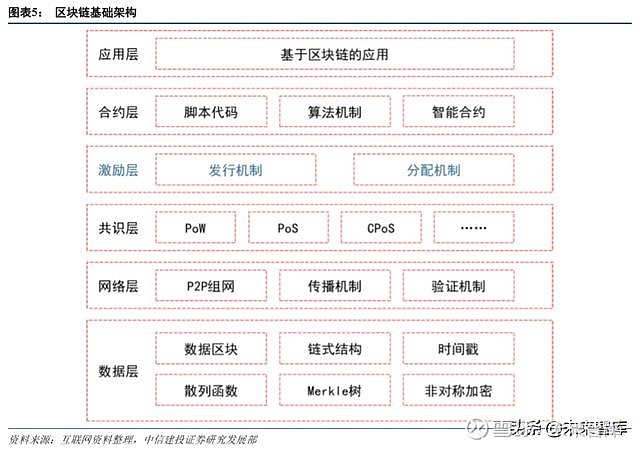
区块链并不是一项单一的技术创新,而是 P2P 网络技术、智能合约、共识机制、链上脚本、密码学等多种 技术深度整合后实现的分布式账本技术。区块链技术利用加密的链式区块结构来验证和存储数据,利用 P2P 网络技术、共识机制实现分布式节点的验证、通信以及信任关系的建立,利用链上脚本能够实现复杂的业务逻辑 功能以对数据进行自动化的操作,从而形成的一种新的数据记录、存储和表达的方法。
The block chain is not a single technological innovation, but a distributed account technology that is achieved by a variety of technological depth integrations, such as P2P network technology, smart contracts, consensus mechanisms, chain scripts, cryptography, etc. Block chain technology uses an encrypted chain block structure to validate and store data, using P2P network technology, consensus mechanisms to validate distributed nodes, communications and trust relationships, using a chain script to achieve complex business logic functionality to automate the operation of data, resulting in a new method of data recording, storage and expression.
二、产业区块链现状:中美创业氛围浓厚,技术应用日益多样化
2.1 相关产业政策:美国财政补贴鼓励区块链技术发展,我国产业政策和政府基金积极推动行 业应用发展
2.1 Related industrial policies: U.S. fiscal subsidies encourage block-chain technology development, and our industrial policy and government funds actively promote industry application development
区块链项目扶持政策主要分为财政补贴、注册条件和产业政策三个方面。美国在财政补贴较为突出,但产业政策推动一直较慢。中国明确禁止 ICO 项目,但在产业政策方面对应用类的区块链项目支持较多。
In the United States, fiscal subsidies are more prominent, but industrial policy has been slower. China explicitly prohibits 财政补贴方面,美国和英国的政策较为突出。美国联邦层面的财政部、国土安全局、航空航天局等提出过 相关的支持政策,如美国国土安全部多次向区块链技术公司颁发研究合同。英国则是国家层面设立基金进行支 持,如 2018 年 1 月英国技术战略委员会宣布投资 1900 万英镑支持区块链等新兴项目研究。 The U.S. Treasury, Homeland Security, and the Aeronautics and Space Administration, among others, have proposed support policies, such as a number of research contracts issued by the United States Department of Homeland Security to block chain technology companies. The United Kingdom, for its part, has set up funds at the national level to support new and emerging projects, such as the US Technical Strategy Committee in January 2018, which announced an investment of £19 million in support of block chains. 产业政策方面,日本和中国较为积极。2014 年日本政府就牵头成立了日本区块链协会(JBA)。在日本的国 家级技术战略中,包括 2016 年的《日本再兴战略》和 2017 年的《未来投资战略》,区块链都是重点关注领域。 中国政府倡导的是无币区块链,提倡用区块链技术服务实体经济,鼓励“脱虚向实”,地方政府方面出台了不少 产业政策。 In Japan, the Japanese government led the establishment of the Japan Block Chain Association (JBA) in 2014. In Japan’s national technology strategy, including Japan’s Re-Growing Strategy in 2016 and the Future Investment Strategy in 2017, the sector chains are focused areas. 中小国家在申请注册方面较为宽松,同时严禁数字货币 ICO。部分中小国家为鼓励区块链项目在当地进行 注册,也出台了一系列政策吸引企业入驻。例如乌兹别克斯坦,任何在当地设立公司并在银行存入资金的企业, 都可获得申请加密货币交易所的许可证资格。而我国则禁止数字货币 ICO,在区块链方面则实行备案制。 Small and medium-sized countries are more liberal in their applications for registration, while the digital currency < a href="https://xueqiu.com/S/ICC?from=status_watch" class="xq_stock" >ICO
总体来看,主要国家均较为支持区块链技术发展,但在数字货币方面则进一步加强监管。
Overall, the major countries are more supportive of the technological development of the block chain, but in terms of digital currency, regulation is further strengthened.
地方产业政策积极,全国区块链投资基金在 400 亿元以上。截至 2019 年上半年,共有 23 个省级行政区发 布了 106 则区块链扶持相关的政策信息。其中,部分城市已将区块链发展计划列入了当地金融业“十三五”发 展规划中。产业基金方面,不完全统计,目前我国地方政府发行的总基金规模在 400 亿元以上。
As of the first half of 2019, 23 provincial districts had distributed 106 block chains to support policy information. Some of the municipalities have included a block chain development plan in the local financial sector's “13th Five-Five” exhibition plan.
2.2 全球区块链研究和融资现状:中美领先全球,美国融资金额一骑绝尘
2.2 Current status of global block chain research and financing: China and the United States are leading the world, with US financing on top of the dust.
全球区块链融资在 2018 年下半年遇冷,2019 年上半年仍未回暖。根据零壹智库统计,2018 年区块链项目 融资总金额达到 416 亿元,共计融资 452 笔,自 2018 年 9 月份后,融资呈现疲软状态,融资减少可能与加密货 币市场大幅下跌有关。2019 年 1 至 6 月融资总额约 165 亿元,比去年同期有所下滑。其中,5 月份单月融资金 额高达 80 亿元,主要是由于 5 月份货币交易所 Bitfinex 发行了平台币 LEO 并获得一笔 10 亿美元的融资。而 Bitfinex 进行这轮融资主要是由于多国监管部门冻结了 Bitfinex 的比特币资产,为缓解承兑压力而进行融资。若 剔除该笔融资,2019 年上半年区块链项目融资均低于 20 亿元,区块链项目融资市场仍未回暖。
Global block-chain financing went cold in the second half of 2018 and remained unheated in the first half of 2019. According to the zero think tank, the total financing of block-chain projects in 2018 amounted to 41.6 billion yuan, with a total of 452 million dollars in financing, and since September 2018 financing has been weak, with a possible reduction in financing associated with a sharp decline in the market for encrypted goods. In 2019, the total financing for January to June was about $16.5 billion, down from the same period last year.
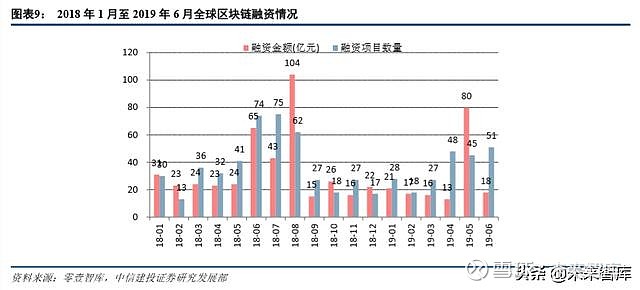
中美区块链项目融资数量、金额均远远领先其它国家。从融资数量看,中美远远领先于其他国家,分别发 生 71 和 64 起。从融资金额看,美国融资金额最高达到 118.1 亿元,虽然融资数量上不如中国,但单笔区块链 项目融资金额更多,即使剔除 Bitfinex 的 10 亿美元融资,也大幅领先其他国家。中国区块链项目融资金额为 25.62 亿元,是第三名英国的三倍以上。整体来看,中美在区块链技术方面的创业、融资环境均要好于其它国家。
In terms of the volume of financing, the US and China are far ahead of other countries, with more than 71 and 64, respectively. In terms of the amount of financing, US financing amounts to up to 118.1 billion yuan, although the amount of financing is lower than in China, the amount of financing for a single block chain project is larger, and even if Bitfinex’s $1 billion financing is excluded, China’s block-chain financing amounts to 25.62 billion, or more than three times that of the third United Kingdom.
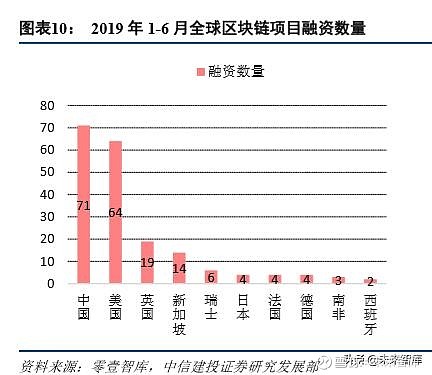
我国专利全球领先,但整体价值有待提高,缺乏底层关键技术研究。根据国家知识产权局的统计,截止到 2018 年第三季度,2018 年度世界主要国家的区块链专利数为 1300 多件,我国年度公开的区块链专利数已经 达到了 1065 件,剔除外国公司在我国申请的专利数量,本土企业、单位和个人公开的专利数为 1001 件,已经 远超 2017 年全年860 件的专利量,中国区块链专利数量占比大约达到了世界主要国家区块链专利数量的77%, 位居全球第一。美国为专利数量为 138 件,相比 17 年也大幅提高,位居全球第二。尽管 2018 中国区块链专利 位列世界第一,但整体价值不高,大部分企业围绕加密数字货币、钱包、存证溯源等应用层开展研发工作,较 少涉及区块链关键技术。从目前区块链最新技术理念和解决方案来看,如 PoS、DPoS 共识算法,分片、零知识 证明、DAG、侧链、闪电网络等技术方案,大多数是外国技术社区提出,国内技术社区进行跟随和模仿,极少属于中国自主原创或最早提出。中国亟需在区块链关键技术方面有所突破,进而推动区块链技术在更大规模的 商业场景中落地。
As of the third quarter of 2018, the number of patents on the chain of blocks in the world’s major countries had reached more than 1,300 in 2018, and the number of patents in our annual open block chains had reached 1065, excluding companies from the number of patents applied in our country, indigenous firms, units and individuals had a total of 1001 patents in the world, far more than 860 patents in 2017, and China’s chain of patents accounted for about 77 per cent of patents on the world’s main country blocks and was the first in the world. The number of patents in the United States was 138, and it was the second in the world in 17. Despite the fact that China’s chain of patents were the first in the world, the total value was not high, most of the enterprises had developed research on applications such as cryptic digital currency, wallets, foreign tracers, etc., and the number of patents on the chain of blocks was the largest technology in the world.
中国区块链专利布局竞争激烈,不仅 BAT 均积极布局,安全企业如 360、服务器企业如浪潮等也开始布局, 初创企业紧随其后。2018 年阿里巴巴区块链数量遥遥领先,联通、腾讯、杭州复杂美紧随其后。其余企业中既 有安全企业 360,也有服务器企业浪潮、保险公司平安、众安,上述公司均布局区块链技术与自身业务形成协 同效应,国内区块链初创企业技术实力较为领先。
In China, the patent distribution of the block chain has been highly competitive, with not only BAT being active, but also security firms such as 360, server businesses such as wave surges, followed by start-ups. 2018: , with links to followed by complex U.S.A.
在区块链顶级论文方面,中美领先全球。硅谷洞察研究院数据显示,全球前 50 个最有影响力的区块链顶尖 论文作者中有 30%来自美国,28%来自中国,42%则来自其他国家。在区块链应用方面,区块链与产业结合的论 文占据了全部论文的 48%。其中,IOT、金融、能源、安全、医疗是被谈及最多的与区块链结合的产业。
Central America leads the world in the top part of the block chain. The Silicon Valley Insight Institute shows that 30% of the top authors of the world’s top 50 most influential block chain are from the United States, 28% from China, and 42% from other countries. In block chain applications, 48% of all the papers are on block chain integration.
2.3 我国产业发展特征:企业数量快速增长,技术应用日益多样化
2.3 Characteristics of our industrial development: rapid growth in the number of enterprises and increasing diversification of technology applications
2018 年底我国区块链企业达 672 家,数量快速增长。根据赛迪区块链研究院统计,2018 年我国具有实际投 入产出的区块链企业共 672 家,其中 2018 年共注册成立 299 家,同比增长 89%,区块链相关企业数量快速增长。 同时,我国初创百强区块链企业近 70%的企业实现了盈利。
At the end of the year, there were 672 block-chain enterprises in the country, which are growing rapidly. According to the Sadi Block-Link Institute, in 2018 there were 672 block-chain enterprises with actual inputs, of which 299 were registered in 2018, an increase of 89% compared to the previous year, and a rapid increase in the number of sector-chain-related businesses.
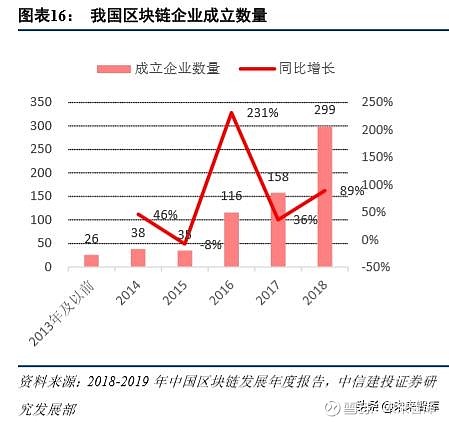
我国区块链产业应用主要分布在金融、供应链、溯源等领域,且应用日益多样化。根据赛迪区块链研究院 统计显示,截至 2018 年底我国从事行业应用研发的企业或项目的企业数量位居首位,占比 38%;其次是底层平 台研发,占比 25%。行业应用主要分布在金融、供应链、溯源等领域。其中从事“区块链+金融”领域的企业有 159 家,占 23.7%,供应链、溯源分别为 77 和 63 家。自 2018 年区块链技术应用日益多样化,区块链技术在医疗健 康、文化娱乐、社会管理、版权保护、教育和共享经济等领域增长趋势明显。
By the end of 2018, the number of enterprises or projects engaged in industrial research and development was the highest in the country, accounting for 38%, followed by bottom-level research and development, accounting for 25%. Industry applications were distributed mainly in the areas of finance, supply chain, traceability, and finance. Of these, 159, or 23.7%, were enterprises working in the area of “block-chain-plus finance” and 77 and 63, respectively. Since 2018, the number of enterprises engaged in sector-chain technology applications has become increasingly diversified, and the growth trend is evident in areas such as medical health, recreation, social management, copyright protection, education and shared economy.
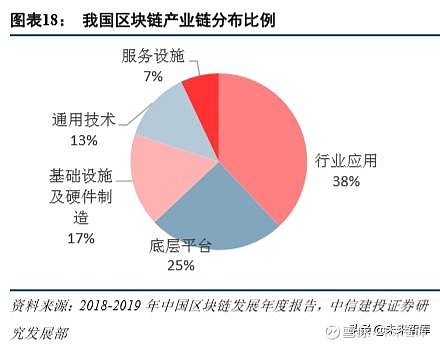
2019 年上半年我国区块链融资集中于企业服务、金融、电子商务等领域,同时行业覆盖规模逐步扩大。根 据赛迪区块链研究院统计,我国 2019 年上半年投融资行业主要涉及于企业服务、金融、电子商务等领域,并逐步扩展至新能源、广告营销等领域,可见投资人对于有具体的应用场景,能够实际落地的项目越来越看重。
In the first half of the year, our block-chain financing was concentrated in the areas of business services, finance, e-commerce, and, at the same time, the scale of industry coverage has gradually expanded. According to the Sadie Block-Link Institute, in the first half of 2019, our investment sector was mainly in the areas of business services, finance, e-commerce, and gradually expanded to 2.4 区块链行业目前面临挑战 2.4 Current challenges for the block chain industry 现阶段面临的挑战:尽管人们已经认识到区块链巨大的应用价值,但区块链技术发展还没有到达成熟阶段。 尤其在企业级商业应用方面,区块链的数据存储能力、通用性、功能完备性、易用性等都还存在明显不足。 Challenges at this stage: While the value of block chains in applications is recognized, the technological development of block chains has not yet reached maturity. There are significant gaps in the data storage capacity, interoperability, functional integrity, and ease of use of block chains, particularly in business applications at the enterprise level. 1、 区块链数据只有追加而没有移除,数据存储能力要求高。由于区块链的数据只有追加而没有移除,数 据只增不减,随着时间推移,区块链系统对数据存储大小的需求也将持续增大。尤其是在企业场景下, 具有大量的结构化和非结构化的庞杂数据,以电商供应链为例,每日数据记录条数通常都在千万级以 上,如再沿着供应链条进一步展开时,每延伸一级数据量都会进一步放大。 1. Block chain data are only added and not removed, and data storage capacity is high. Since block chain data are only added and not removed, the numbers are increased and the demand for data storage sizes in block chain systems will continue to grow over time. 2、 仍需多技术协作才能保证上链前的数据真实有效。区块链技术只能确保“链上”的信息不被篡改,保 证这部分内容的可信度,然而区块链难以独立解决上链之前源头数据的可信度问题,需要信息安全技 术、物联网、AI 和其他技术的共同协作。 2. There is still a need for a number of technical collaborations to ensure the validity of data prior to the chain. Block chain technology can only ensure that information “on the chain” is not tampered with and that the credibility of this element is safeguarded. However, the block chain cannot independently address the credibility of source data prior to the chain. It requires collaboration between techniques, material networking, AI and other technologies. 3、 区块链安全问题日益突出。 区块链技术本身和架构目前都存在安全风险,安全问题和加密技术仍有较 大提升空间。如在协议层面临协议漏洞、流量攻击和恶意节点等多种安全隐患;在扩展层则存在代码 实现中的安全漏洞;在应用层则涉及私钥管理安全、账户窃取、应用软件漏斗、DDoS 攻击、环境漏洞 等安全问题。 Block chain security issues are becoming more prominent. Block chain technology itself and architecture present security risks, and security issues and encryption technologies still have greater scope for upgrading. 4、 为了实现真正的多方数据共享,隐私计算技术仍有较大提升空间。隐私计算技术是一类在保证数据提 供方不泄露敏感数据的前提下,对数据进行计算并能验证计算结果的技术,密码学层面的隐私计算主 要有全同态加密(Full Homomorphic Encryption,FHE)、多方安全计算(Secure Multi-Party Computation,sMPC)、零知识证明(Zero-knowledge Proof)三种主要的技术方向,都有各自对应的问题和优势。目 前隐私计算技术效率较低,实际的商业应用较少,但是如果要多方真正愿意将真实数据在链上共享, 打破数据孤岛,必须要在隐私计算技术上得到提升,未来隐私计算在安全云计算、分布式计算网络和 加密区块链三个方向将有较广的应用前景。 4. In order to achieve genuine multiplicity of data sharing, there is still much room for privacy computing techniques. Privacy computing techniques are those that enable data to be calculated and validated without disclosure of sensitive data by the supplier, and privacy computing masters at the cryptographic level need to have full homogeneity encryption (Full Homomorphic Enterprise, FHE), multi-security computing (Secure Multi-Party Computation, sMPC), zero-knowledge certification (Zero-knowledge Proof) with their respective corresponding problems and advantages. 5、 通用型方面仍有明显不足。为了适应多样化的业务需求,满足跨企业的业务链条上的数据安全高效共 享,区块链对数据的记录方式要有足够的通用标准,才能很好地表示各种结构化和非结构化的信息。 目前的区块链系统大多采用特定的共识算法、密码算法、账户模型、账本模型、存储类型,缺少可插 拔能力,无法灵活适应不同场景要求。 In order to accommodate diverse business needs and to meet the security and efficiency of data sharing along the cross-enterprise business chain, blocks’ chains need to record data in a manner that is sufficiently common to present a variety of structured and unstructured information. Most of the current block chain systems use specific consensus algorithms, password algorithms, account models, book models, storage types, lack of plug-in capabilities, and lack of flexibility to adapt to different scenarios. 6、 功能尚不完备,缺少对企业级应用一些常见功能的支持。现有区块链平台模型抽象单一,难以适应业 务系统快速开发的要求。另外,缺少对企业级应用中一些常见功能的支持,例如用户认证、多级授权 等。再者,涉及到企业业务协作时,跨企业的事件通知机制显得尤为重要,但少有区块链平台进行了 相关功能支持。 6. The functionality is incomplete and lacks support for the application of some of the common functions at the enterprise level. The existing block-chain platform model is abstract and difficult to adapt to the requirements of rapid development of the business system. There is also a lack of support for some of the common functions in enterprise-level applications, such as user certification, multilevel authorizations, etc. 7、 区块链由多种技术构成,学习成本高、实施难度大、人才稀缺。让用户快速理解区块链,降低学习和 使用门槛,并将区块链技术快速应用到不同行业的企业级业务中去,目前来看还有很大的挑战。同时, 区块链是综合学科,涉及到密码学、数学、经济学、社会学等多个学科,对人才综合要求高,目前人 才来源主要是公司项目实践和社会培训,高水平的区块链人才仍然非常缺乏。当前全国仅有清华大学、 北京航空航天大学、浙江大学、上海财经大学、同济大学、西安电子科技大学等少数高校开设区块链 相关课程。尤其是既懂区块链底层技术,又懂区块链架构和经济模型设计的复合型、专业性、创新性 人才严重缺乏。 At the same time, the block chain is a complex discipline involving multiple disciplines, such as cryptography, mathematics, economics, sociology, and a high demand for combined talent, which is still largely based on company project practice and social training, and a high level of talent is still scarce. Only a few high-level universities such as Qinghua University, Beijing University of Aeronautics and Space, Zhejiang University, Shanghai University of Finance and Finance, Hoji University, and Xian University of Electronics and Technology are currently offering courses. In particular, there is a serious shortage of complex, specialized and innovative talent, both in the lower part of the sector chain and in the design of the sector chain structure and economic model. 2.5 产业区块链未来发展展望 2.5 Prospects for the future development of the industrial block chain 区块链基础设施研究投入将进一步加大。贸易战为国内自主技术研发敲响了警钟,没有自主研发的技术将 可能成为制约公司甚至国家发展的短板。区块链技术被预测为引领第五次技术革命的重要技术。在这样全球聚 焦,多国鼓励的宏观趋势背景下,对区块链技术底层的研究与探索将会越来越重要。无论是区块链的存储技术 (链上信息与线下信息对应和防篡改)、技术、共识机制和跨链技术研究。 Research and exploration of the bottom of the block chain will become increasingly important in the context of global concentration, the macro-level trends encouraged by many countries. Whether it is the storage technology of the block chain (information on the chain and information under the line and against tampering), technology, consensus mechanisms and cross-linkages . BaaS 平台的大规模应用。未来区块链技术将率先改变企业应用,企业将业务“上链”的过程势必要更加简 单快捷,否则将无法跟上经济的高速发展。BaaS(Blockchain as a Service)平台为企业快速部署区块链提供了 便捷的通道。未来在大规模企业级应用中,BaaS 平台必将作为基础级设施在企业推广区块链的道路上发挥重要 作用。如目前阿里云在公有云端提供企业级区块链服务 BaaS 平台,也提供可私有化部署的区块链平台 BaaS 敏 捷版。 The future block chain technology will take the lead in changing business applications, and the business “uplink” process will need to be simpler and faster, otherwise it will not be able to keep pace with the rapid pace of economic development. The BaaS ( 对于通证(Token)合理应用和设计思路越来越重要。在区块链应用落地过程中,不可避免需要考虑价值 转移问题,通证 Token 通常被认为是可流通的加密数字权益证明,可作为价值交换的媒介,不论是 C 端还是 B 端,通证是一把双刃剑,用得好可以大大助力整个应用生态体系的发展,用不好则容易伤及自身。未来在区块 链项目中引入通证及如何对通证体系设计变得至关重要,彻底变革生产关系、分配机制、商业模式和社区治理 等,多元化的激励方式,让更多用户自发地融入整个应用生态发展中,而不是像虚拟货币之前的发展一样盲目 发币收割韭菜。 It is increasingly important to apply and design rationally to Token. In the course of block-chain applications, it is inevitable that values need to be taken into account. Transfers. Translator Token is often considered to be a tradable certificate of cryptographic digital equity, which can be used as a medium for value swaps, whether C-end or B-end, which is a double-edged sword that, when well used, can contribute significantly to the development of the whole application of the ecosystem and can be hurt itself. In the future, introducing translator in block-line projects and how it can become critical to the design of translator systems, radical changes in production relations, distribution mechanisms, business models and community governance, etc., and diversified incentives that allow more users to integrate spontaneously into the whole application of eco-development, rather than blindly, as in the case of virtual money, to harvest their vegetables. 区块链如何深度融入到传统产业中,通过融合、共享和重构等方式助力传统产业升级,重塑信任关系,提 高产业效率,弥补金融和实体产业间的信息不对称,解决金融脱实入虚问题,建立高效价值传递机制,帮助企 业商流、信息流、资金流达到“三流合一”。在金融科技领域将迎来更加深入的发展。区块链技术在金融应用场 景中诞生,虽然如今很多应用已经脱离了金融领域,但金融场景依然是区块链技术最契合的场景,特别是在身 份识别、数据确权、信用管理、价值流转、交易清结算等方面,利用区块链解决金融场景中的信任问题,可以 为企业节省成本,提升效率,创造巨大商业发展潜力。 In the area of financial science and technology, deeper development will take place. Block-chain technology has emerged in the financial arena, where, although many applications are now out of the financial field, the financial landscape remains the most relevant one, particularly in the areas of physical identification, data validation, credit management, value flow, and trade clearing, and the use of regional chains to address the issue of trust in the financial landscape. 3.1 区块链市场规模将呈现指数级增长,全球 2022 年预计整体市场规模达到 124 亿美元 3.1 The size of the segment chain market will grow exponentially, with the global total expected to reach $12.4 billion in 2022 2018 年全球区块链市场支出规模约 15 亿美元,预计 2022 年将达到 124 亿美元。根据 IDC 最新发布的《全 球半年度区块链支出指南》,指出 2019 年全球区块链的支出将达到近 29 亿美元,同比 2018 年 15 亿美元支出, 预计增长 88.7%,预计 2022 年将达到 124 亿美元 Global block chain spending in 2018 was about $1.5 billion, and is expected to reach $12.4 billion in 2022. According to the latest IDC semi-annual block chain expenditure guide, it is indicated that global block chain spending will reach nearly $2.9 billion in 2019, compared to $1.5 billion in 2018, an increase of 88.7 per cent, and is projected to reach $12.4 billion in 2022. 2018 年中国区块链市场支出规模达 1.6 亿美元,预计 2022 年将达到 16.7 亿美元,2019-2022 年均复合增长 率约 80%。IDC 数据显示,2018 年中国区块链市场支出规模达 1.6 亿美元,较 2017 年增长 108%。同时,更多 企业计划在未来增加相关预算,受此影响,预计未来三年中国区块链市场将保持快速增长,2022 年的市场支出 规模预计达到 16.7 亿美元,2019-2022 年的年均复合增长率约 80%。金融行业的区块链支出规模最大、占比最 高。根据 IDC 统计,目前中国金融、制造、零售三个行业在 2018 年的区块链市场支出占整体市场总支出比例 超过 75%。其中,金融行业的区块链支出规模最大、占比最高。 In 2018, China’s block-chain market expenditure amounted to $160 million, and is expected to reach $16.7 billion in 2022, with an average annual compound growth rate of around 80 per cent. IDC data show that in 2018 China’s block-chain market expenditure amounted to $160 million, an increase of 108 per cent over 2017. At the same time, more enterprises are planning to increase their budgets in the future, with China’s block-chain market expected to grow rapidly over the next three years, with the market spending projected to reach $16.7 billion in 2022 and about 80 per cent in 2019-2022. 3.2 区块链目前应用场景:数据存证和电子票据是基础,泛金融领域应用场景较为丰富 3.2 Sites for the current application of block chains: data storage and electronic instruments are the basis and the pan-financial applications are rich 国内区块链主要应用领域可以为几大类:数据存证和电子票据、金融、能源电力、智慧城市、供应链和溯 源。 The main areas of application of the domestic block chain can be several broad categories: data documentation and electronic paper, finance, energy power, smart cities, supply chains and traceability. 数据存证:区块链的去中心化、安全性和不可篡改可追溯性,可以让参与主体之间建立信任,推进数据交 易的可持续大幅增长:数据所有权、交易和授权范围记录在区块链上,数据所有权可以得到确认,精细化的授 权范围可以规范数据的使用。同时,数据从采集到分发的每一步都可以记录在区块链上,使得数据源可追溯, 进而对数据源进行约束,加强数据质量。基于区块链的去中心化数据交易平台,可以形成更大规模的全球化数 据交易场景。 Data record: Decentralization, security and non-retroactivity of block chains allow for confidence-building among participating subjects and facilitate easy and significant sustainable growth in data exchange: data ownership, trading and authorization are recorded on block chains, data ownership can be recognized, and refined delegation of authority can regulate the use of data. At the same time, every step from collection to distribution can be recorded on block chains, allowing data sources to be traced back, thereby constraining data sources and enhancing data quality. 电子票据:相比纸质票据和普通电子票据,区块链技术应用于电子票据,可在一个链条上接入包括医院、 学校、交警、法院等在内的大量开票单位,还可以接入医保、企业、商保等一系列用票单位,且区块链电子票 据从生成、传送、储存到使用的全程中都盖上“戳”,全程可溯源、不可篡改,保证了票据的真实性和唯一性, 也避免了票据的重复使用。 Electronic instruments: Compared to paper-based instruments, block-chain technology is applied to electronic instruments, with access to a chain of large ticketing units, including hospitals, schools, traffic police, courts, etc., as well as to a range of ticketing units, such as health insurance, businesses, commercial security, and electronic block-chain tickets, which are “tamped” throughout the process of generation, transmission, storage and use, are traceable, non-disposable, guarantee the authenticity and uniqueness of the instrument and avoid the duplication of the use of the instrument. 泛金融:区块链技术特性中的分布式存储和数据不可篡改、可溯源,与金融行业对信息和数据安全、交易 数据溯源等业务的本质需求高度契合,因此区块链将在金融领域发挥价值,其能给金融行业带来改变包括 1) 提高数据可靠性,链接各方企业与金融机构,可以完整地记录数据,数据经过多方记录确认、不可篡改,同时 可以追溯、有效提高数据的可靠性;2)提高金融服务效率,传统金融存在信息传输效率低下、金融服务成本较 高等问题。区块链技术的分布式存储、不可篡改、时间戳验证等属性,可以帮助金融机构优化金融基础架构、 降低信息不对称程度、提高金融服务效率并降低成本;3)提高安全性,现代金融中心化体系下,如果中心节点 受到威胁和攻击,整个体系结构都面临崩溃风险。因此区块链技术可以帮助金融机构改善体系机构和服务模式, 提升安全性。 Pan-financial: Distributive storage and data in the technical characteristics of the block chain are highly compatible with the essential needs of the information and data security, transactional traceability, so that the block chain will have value in the financial sphere and will bring about changes in the financial sector, including 1) improving the reliability of the data base, linking enterprises and financial institutions, allowing data to be fully recorded, validated by multiple records, not tampered with, while improving data reliability retroactively and efficiently; 2) improving the efficiency of financial services, with traditional financial systems having inefficient transmission of information, higher costs of financial services. 能源电力行业:区块链能帮助国家电网系统实现数据高效共享,提升风险防范能力,有效解决泛在电力物 联网建设过程中面临的数据融通、网络安全、多主体协同等问题国家电网打造了基于区块链的电子合同、电力结算、供应链金融、电费金融、大数据征信等金融科技全产业链产品,适应担保、融资、交易等多类型应用场 景,形成了“1+5+N”区块链金融风控架构体系,通过建立区块链治理新机制,推动风控技术升级,增强金融 行业风险管控能力。 Energy and electricity industry: Block chains can help national grid systems to achieve efficient data sharing, enhance risk prevention capabilities, effectively address data integration, network security, multi-subject synergies and other issues that are common to electricity grid development. National grids have developed electronic contracts based on block chains, electricity settlements, supply chain finance, electricity finance, large data letters, etc. 电子政务和智慧城市:区块链可以在税务、工商登记系统、个人记录管理、城市间信息互通、城市能源、 产权公证、选举投票、学术存证和公益慈善等领域很好地结合。IDC FutureScape 报告显示到 2022 年,全球将有 1.5 亿人拥有 基于区块链的数字身份。 E-government and smart cities: Block chains can be well combined in the areas of taxation, business registration systems, personal record management, city-to-city information exchange, urban energy, property rights notarization, electoral voting, academic documentation and public good philanthropy. The IDC FutureScape report shows that, by 2022, 150 million people worldwide will have digital identity based on the chain of blocks. 供应链及溯源:实现农产品、工业品、工艺品等商品的生产、加工、运输、流通、零售等环节的追踪记录。 主要依托的是区块链技术具有的数据不可篡改、交易可追溯以及时间戳的存在性证明机制,可以很好的解决供 应链体系内各参与方在数据被篡改时产生的纠纷,实现有效的追责和产品防伪。 Supply chain and traceability: track records of the production, processing, transport, circulation, retailing, etc. of goods such as agricultural products, industrial goods, handicrafts, etc. The primary reliance is on data integrity, traceability of transactions and proof of the existence of time stampes in block chain technologies, which can be a good way to resolve disputes among participants in the response chain when data are tampered with, and to achieve effective accountability and product security. 区块链在车联网中可用于车辆维修、改装、维护环节,故障权责界定、保险理赔、二手车车况取证等多环 节。车联网是基于网络连接、车载传感器数据收集,配合云端的设备管理、大数据分析等技术的融合,并加上 大量的应用创新而形成的一种综合性技术。利用区块链,可以通过数据防篡改和可追溯的统一账本来记录车辆 整个生命周期的信息,该账本在各参与方之间共享(参与方既可以是信息提供者,又可以是信息使用者),实现 去中心化的信息互通。同时结合智能合约、链上链下数据互通等更前沿的技术,可实现整个价值链上各种流程 的自动化,进一步提升效率。例如基于车辆的生命周期信息,可以考虑将区块链用于出厂/维修/改装/维护、故 障权责定界、保险理赔、二手车车况取证等场景。 Block links can be used for vehicle maintenance, retrofitting, maintenance, fault rights definition, insurance compensation, second-hand vehicle condition forensics, etc. Interconnectivity is based on network connections, data collection from vehicle-borne sensors, integration with equipment management at cloud ends, big data analysis, and a combination of a wide range of innovative applications. Block chains can be used to record vehicle information throughout the life cycle by data protection and retraceable consolidated accounts, which are shared among participants (both providers and users of information) to achieve information interchange for centralization. Together with more cutting-edge technologies such as smart contracts, data interchange between chains, etc., can automate processes across the entire value chain and further improve efficiency. For example, based on life-cycle information on vehicles, the use of block chains for plant/maintenure/reform/mainance, liability, insurance compensation, and second-hand vehicle forensics can be considered. (1)区块链在数字存证场景应用 (1) Block chain application in digital record-keeping scenes 区块链最初与产业融合的场景就是数据存证,也是产业发展的基石。上链后的数据不可篡改,配合物联网 手段保证数据的真实性,因此存证优先切入对信任需求敏感或对数据真实性要求高的场景,在司法、金融、公 益、政务、版权、医疗等领域均有大量尝试,正逐渐成为应用方向之一。数据存证主要解决数据的真实性问题, 为各产业企业间多方协作打下重要的信任基础,结合智能合约、身份认证和隐私保护、加密等技术,简化合作 流程、提高协作效率,强化互信合作。存证是整个产业区块链未来高速发展的重要基础,涉及数据的采集、保 全和共享等流程,可在其基础上拓展延伸功能也较为丰富,如身份认证、数据交换、资产交易和共享经济等, 因此存证的基础越扎实,多方协作越顺畅,未来想象空间也越大。 The initial integration of the block chain with the industry is data documentation, which is the cornerstone of industrial development. Data from the upper chain cannot be tampered with, coupled with data networking tools to ensure data authenticity. As a result, records prioritize scenarios sensitive to the need for trust or demanding data authenticity. There are numerous attempts in the areas of justice, finance, public welfare, government, copyright, and medical care. 个人就医信息在医院、药企、医保局、食药监局和商业保险公司等机构间流转,一旦泄露或者出错,很难查到泄露龙头。可以利用区块链技术,将所有知情方纳入区块链,再通过商企实现实时可查可监督,链上各个节点共享利用,多方存证,实现信息可追溯,保证了链上安全。目前腾讯在广西柳州的微信挂号、支付等功能尝试中,实现了全国首例“院外处方流转”服务,即院内开处方,院外购药,甚至送药上门。由于处方流转设计卫计委、亿元和药企等多个环节,因此通过区块链技术, 可以实现处方不被篡改,防止隐私信息泄露的目标。 It is difficult to identify leaks when medical information flows between hospitals, pharmaceutical companies, health insurance offices, FDA and commercial insurance companies, among others. It is possible to use block-chain technology to integrate all parties of knowledge into the block chain, and to achieve real-time detectability through business enterprises, sharing of information across the chain, multiple records, back-to-back information. At present, (2)区块链在泛金融领域应用 (2) The use of the block chain in the broader financial field 金融是一个几乎全部可实现数字化的行业,同时现有金融存在大量问题均可用基于区块链技术的解决方案 解决,因此区块链在泛金融领域取得最多应用场景和实际案例的原因。目前泛金融领域面临的主要问题包括: 1) 跨境支付周期长,费用高。不少跨境支付到账周期都在一周左右,且手续费较高,如 Paypal 普通跨境支付交易 手续费为 4.4%+0.3 美元;2)融资周期长、成本高,审核机构工作量大,中小企业融资难。对于中小企业的融 资而言,第三方征信机构和银行需要花费大量时间去审核企业的各种凭证以及账款记录,由于工作量大,人员 核验成本高,因此针对中小企业融资费用高,而且大部分时候都缺乏有效数据和手段对中小企业提供贷款和融 资;3)票据市场中心化风险较大。票据市场依赖于中心的商业银行,一旦中心服务器出现故障,票据市场随之 瘫痪,并且市场上一票多卖以及虚假商业汇票问题也是时有出现; Finance is an industry that can be digitalized almost entirely, and there are a number of problems with existing finance that can be solved by solutions based on block-chain technologies, so that the block chain has the most applied scenes and practical cases in the pan-financial field. The main problems facing the financial sector are: 1) long cross-border payment cycles and high costs. 2) long-term financing cycles, high costs, high audit agency workloads, and difficulties in financing SMEs. For small and medium-sized enterprises (SMEs), third-party credit agencies and banks will have to spend considerable time reviewing business vouchers and accounting records, owing to the high workload and the high cost of nuclear testing for ordinary cross-border payments of $4.4 per cent + 0.3 United States dollars; 2) long-term financing cycles, high costs, high auditing agency workloads, and difficulties in financing SMEs. 区块链技术最受益的是参与者之间信任度低、交易记录安全性和完整性要求较高的行业,而金融业正是其 中之一。金融的本质是信用,通过信用使得不同的参与者之间进行资金的流通和配置,因此金融行业有大量中 心化的中介机构。中心化模式使得各中心之间的互通成本高、运作效率低,同时容易受到攻击和篡改,数据不 安全。高盛报告显示,区块链或分布式账本技术每年可为金融行业节省成本 50-70 亿美元,主要应用案例:数 字货币、跨境支付结算、数字票据、供应链金融、贸易融资等。 Block chain technology benefits most from industries with low confidence among participants and high security and integrity requirements for transaction records 供应链金融:参与方包括核心企业,中小企业,金融机构和第三方支持服务。其中,在供应链链条上下游 中拥有较强议价能力的一方被称为核心企业,供应链金融上下游的融资服务通常围绕核心企业所展开。由于核 心企业通常对上下游的供应商、经销商在定价、账期等方面要求苛刻,供应链中的中小企业常出现资金紧张、 周转困难等情况,导致供应链效率大幅降低甚至停止运转。 Supply chain finance: Participants include core enterprises, small and medium-sized enterprises, financial institutions, and third-party support services. Among them, the party with a stronger bargaining power up and down the chain of supply chains is referred to as a core enterprise, and financial services up and down the supply chain typically revolve around core enterprises. Due to the often demanding requirements of nuclear enterprises for upstream and downstream suppliers, distributors, etc., SMEs in the supply chain often experience financial constraints, liquidity difficulties, etc., that lead to a significant reduction in supply chain efficiency or even to a failure to function. 因此,供应链金融产业面临的核心问题是中小企业融资难,融资贵,成本高,周转效率低。供应链金融平 台、核心企业系统交易本身的真实性难以验证,导致资金端风控成本居高不下。供应链中各个参与方之间的信 息相互割裂,缺乏技术手段把供应链生态中的信息流、商流、物流和资金流打通,信息无法共享从而导致信任 传导困难、流程手续繁杂、增信成本高昂,链上的各级数字资产更是无法实现拆分、传递和流传。 As a result, the core issues facing the supply chain financial sector are the difficulty of financing SMEs, their high cost of financing, and their low turnover and efficiency. The trueness of supply chain financial platforms and core business system transactions per se is difficult to verify, resulting in high capital-winding costs. Trust among the various players in the supply chain is fragmented, there is a lack of technical means to communicate the ecological flow of information, business flows, logistics and financial flows in the supply chain, and information is not shared, leading to trust transfer difficulties, cumbersome processes, high incremental costs, and digital assets at all levels of the chain are not separated, transmitted and transferred. 区块链技术可以实现供应链金融体系的信用穿透,为二级供应商分销商解决融资难、融资贵的问题。区块 链在其中发挥两个作用,首先是核心企业确权过程,包括整个票据真实有效性的核对与确认;其次是证明债权 凭证流转的真实有效性,保证债权凭证本身不能造假,实现信用打通,进而解决二级供应商的授信融资困境。 在这个信任的生态中,核心企业的信用(票据、授信额度或应付款项确权)可以转化为数字权证,通过智能合 约防范履约风险,使信用可沿供应链条有效传导,降低合作成本,提高履约效率。更为重要的是,当数字权证 能够在链上被锚定后,通过智能合约还可以实现对上下游企业资金的拆分和流转,极大的提高了资金的转速, 解决了中小企业融资难、融资贵的问题。 Block-chain technology allows credit to penetrate the supply chain financial system, and solves difficult and expensive financing problems for secondary suppliers. Blocks play two roles in the chain, first in the process of securing the rights of the core business, including the reconciliation and confirmation of the true validity of the entire instrument; and second in the demonstration of the true validity of claims, in order to ensure that the documents are not fraudulent in themselves and that credit is channelled, thus resolving the problem of second-tier financing. …… 贸易融资:贸易融资是银行利用结构性短期融资工具,基于商品交易中的货币、账款等为交易进行融资, 是银行对公业务中最主要业务之一。一直以来贸易融资存在核验流程复杂繁琐、时效性差和信息不透明等问题, 银行需要核验交易双方大量的信息、数据与款项,单据与信息基于原始渠道的传递会让交易丧失时效性。交易 的各方参与信息来源单一,信息不透明且不完整,这不仅使交易面临风险,也会造成较高的融资成本。区块链 可以解决贸易融资过程中的两大痛点:1)提升效率,基于区块链的网络系统可覆盖贸易融资中各环节参与方, 使多方拥有统一账本,省去对账环节,打通贸易数据流,提升效率。贷前调查、贷中审核、贷后管理等贸易融 资相关流程可以通过数字化的加密传递以及智能合约的推动执行得到简化,传统所需的人力投入和纸质文件通 过电子化处理,极大地提高了单据流转速度,提升效率。2)降低欺诈风险:链上数据流转可降低人为操作风险, 基于区块链的贸易融资平台打通多方贸易数据流,使银行能够更便捷地核实数据真伪,进行身份和信息的验证 和对比,有效降低造假风险,避免重复融资及融资诈骗。 Trade finance: Trade finance is a structured short-term financing tool used by banks to finance transactions on the basis of currency, accounts, etc. in commodity transactions, and is one of the most important aspects of their public operations. There have been problems with trade finance, such as the complexity of the process, the lack of timeliness and the lack of transparency of information. Banks need to verify large amounts of information, data and money on both sides of the transaction, and the transmission of documents and information on the basis of original channels can make transactions time-barred. Trade-related processes, such as pre-lending surveys, mortgage audits, post-credit management, can not only expose transactions to risks, but also lead to higher financing costs. Block chains can address the two main pains in the trade finance process: 1) increase efficiency, network systems based on block chains can cover the various segments of trade finance, improve electronic flow speeds, save the reconciliation of accounts, improve efficiency. 2) Trade-related processes, such as credit, middle-account audit, post-credit management, can reduce the risk of market-based and information flow, and can reduce the risk of market-based trade-to-to-to-to-to-to-trade data, by means-to-to-to-to-to-to-to-to-trade-to-to-to-to-to-to-to-to-to-trade data, with-to-to-to-to-use data. 智慧税务:区块链电子发票是从开具、报销到申报的全流程管理解决方案,“假票真开、真票假开”一直是 传统发票的痛点,区块链技术可以实现税款计算和汇缴流程的自动化,从而降低税收征管成本且提高交易数据 的安全性。同时也有助于价值链分析,帮助税务机关在全球范围内识别创造价值的经济活动,并据此征税。从 开票企业角度,使用区块链电子发票无需购买税控器具、线上智能注册、按需开具发票、免除抄报税等优势; 从受票方角度,消费后自主获取、支付即开票、开票即报销,以及流畅的操作体验为获得了消费者良好的口碑; 对于报销企业而言,解决了企业最担心的“一票多报”和“假发票”等问题,减轻了企业财务人员收票审核的 工作量,降低财务管理风险及税务违法风险。深圳市税务局和腾讯合作推出了全国首个区块链电子发票解决方 案,并于 2018 年 8 月落地。截至 2019 年 10 月底,已接入企业超过 7600 家,开票数量突破 1000 万张,开票金 额超 70 亿元。目前,区块链电子发票被广泛应用于金融保险、零售商超、酒店餐饮、停车服务等上百个行业。 Wisdom tax: The electronic invoice for the block chain is the solution for full process management from the time it is issued and reimbursed to the time it is declared, and the “false ticket is genuinely opened and genuinely paid off” has been the painful point of the traditional invoice. The block chain technology allows the automation of tax calculation and remittance processes, thereby reducing the cost of tax collection and improving the security of transactional data. It also contributes to value chain analysis, helping tax authorities to identify and tax value-creating economic activities on a global scale. From the point of view of the invoiced enterprise, the use of the electronic invoice for the block chain does not require the purchase of tax control devices, smart registration on the line, the issuance of invoices on demand, exemption from the tax. (3)区块链在能源电力领域应用 (3) Block chain applications in the field of energy and electricity 目前,国家电网区块链项目一方面以通用型技术为代表,包括电子合同、电力结算、供应链金融、电费金 融、大数据征信等金融产品,适应担保、融资、交易等多类型应用场景;另一方面则体现行业特色,如需求侧 响应、能源补贴、共享储能等等。 Currently, the national grid block chain project is represented by generic technologies, including e-contracts, power settlements, supply chain finance, financial products such as electricity charges, large data letters, adaptation to multiple applications such as guarantees, financing, transactions, etc., and by industry features such as demand side responses, energy subsidies, shared storage energy, etc. 通用性技术方面:基于区块链技术自主打造的电 e 贷、电 e 票等金融服务产品,为电费金融类应用提供票 据保存、链上审核、票据溯源、流转管理等功能,实现了票据全程可查、可验、可信、可追溯。基于区块链的 电子合同,利用智能合约技术、结合区块链身份认证机制,为企业、个人提供具有法律效力的线上合同全流程 管理与存证、取证服务。比如浙江宁波供电公司开发的“链无忧——基于区块链技术的停电险”项目。通过利 用区块链分布式存储、不可篡改等特征,将电网停电等数据放入区块链,一旦投保用户发生停电,保险公司无 需人工现场核损,即可基于链上数据按停电时长自动实时理赔; (a) General-purpose technical aspects: financial services products, such as e-credit, e-tickets, built autonomously based on block chain technology, which provide tickets for the use of electricity-related financial applications, such as preservation, chain-checking, paper-retroactivity, flow management, etc., which achieves the full scope of the document, detectability, credibility and traceability. Electronic contracts based on block-chains, using smart contract techniques, combination of block-chain identification mechanisms, and providing companies and individuals with legally valid online contract-wide processes, management and record-keeping, and evidentiary services. For example, the “chain-free” project developed by Zhejiang Ningbo Power Supply Company, based on block-link technology, allows automatic real-time compensation based on chain-based data when power is shut down, using features such as chain distributional storage, non-diversion and so on. 行业技术方面:今年 1 月国网浙江上线国家电网首个自主研发的区块链应用平台。围绕着该平台已经开发 出多种应用:一是需求侧响应,今年 10 月 1 日至 3 日,浙江首次实施填谷需求响应,缓解节假日期间低谷时段 电网运行调节压力,响应实际参与户数 540 余户,最大填谷负荷 52 万千瓦,合计响应电量 730 万千瓦时。电力 需求侧响应采用了区块链技术来实现数据共享。基于区块链技术,可将实时负荷数据上链,并且提供给电网公 司、省能源局、用户等相关利益方,确保不同主体的数据一致性,用户可在网站查询相关数据,并能对上链数 据进行校验,实现需求侧管理创新;二是能源补贴,国网在嘉兴海宁进行光伏补贴业务的试点验证,研发了区 块链网关用于光伏发电数据的采集,并在嘉兴海宁分布式光伏用户现场部署了 8 套区块链网关,初步实现了基 于区块链的光伏发电数据采集,探索了从采集设备端直接将数据发送给用户、监管部门等相关方。 In terms of industry technology: This January, the first autonomous grid-based grid application platform developed in the Zhejiang Upstream State Power Network. A variety of applications have been developed around the platform: one side-to-side response to demand, the first time Zhejiang has implemented a feed-up needs response from 1 to 3 October this year, easing the pressure on the low valleys during the holiday period, the power grid operation, responding to the physical participation of more than 540 households with a maximum cereal load of 52 million kWh, responding to a total electricity capacity of 7.3 million kWh. The power supply side response has resulted in data-sharing using the block-to-chain technology. Based on block-side response, the grid technology has developed a direct power grid chain chain chain that can be used by the grid general division, provincial energy authorities, users, etc., to ensure consistency of data between the main subjects, access relevant data from the website and can be verified from the upper chain to achieve demand-side management innovation. 国网青海实现利用区块链技术完成共享储能市场化交易。青海在光伏装机规模快速扩大的同时,受系统调 峰能力不足、市场机制不健全等多种因素影响,其新能源发展面临着消纳难、电量贡献小、发电调节灵活性差、 波动性强等问题。新能源发电站和储能电站可通过市场化交易方式,进行协商和竞价,通过撮合匹配,按平均 报价成交,最终实现减少新能源发电站弃风弃光。其中,区块链技术保障了多主体间交易的快速撮合、智能研 判,形成交易全过程的大账本,实现数据的精准追溯、不可篡改,保证了交易的公平。今年 6-8 月该项目实现 调峰交易 566 笔,调峰充电电量 470.64 万千瓦时,区块链交易存证数据上千万条。 At the same time as the size of the PV machine is rapidly expanding, the Qinghai is affected by a variety of factors, such as insufficient capacity and market mechanisms, (4)区块链在电子政务和智慧城市领域应用 (4) Block chains applied in the field of e-government and smart cities 在智慧城市建设中,利用区块链技术可以实现数字身份认证、自然资源管理、税务管理和政务诚信管理等。 数字身份数据上链之前先有政府出具权威的信用背书,之后把这些数据上链。安全方面,通过区块链的非对称 加密机制,有效的解决了用户隐私安全的问题。区块链技术可实现政务数据跨部门、跨区域共同维护和利用, 促进业务协同办理,从而全面提高社会治理能力。 In the construction of intelligent cities, digital identification, natural resource management, tax administration, and governance integrity can be achieved through the use of block chain technologies. The digital identity data chain is preceded by an authoritative credit endorsement from the government, which then links them to the chain. 区块链技术有助于政务数据共享,提高办事效率。典型案例如北京海淀区政府服务管理局、不动产登记中 心和国家电网三方实现“不动产登记+用电过户”同步办理。在政务数据共享领域,出于数据安全因素的考虑,电 子政务体系内各个政府部门之间信息孤岛非常严重,在现实情况下,数据共享往往难以真正推进,存在办事入 口不统一、平台功能不完善、事项上网不同步、服务信息不准确等诸多痛点。区块链为跨级别、跨部门数据的 互联互通提供了一个安全可信任的环境,大大降低了电子政务数据共享的安全风险,同时也提高了政府部门的 工作效率。典型案例如北京海淀区借助区块链技术办理不动产登记。海淀区政府服务管理局、海淀区不动产登记事务中心以及国家电网北京海淀供电公司三方利用区块链技术,打通政务服务与公共服务两个领域。在二手 房交易中,实现“不动产登记+用电过户”同步办理,让市民和企业办理不动产登记时,可以一并办理用电过户。 In the area of data-sharing, information-sharing between various government departments within the sub-government system is very serious because of data security considerations. In reality, data-sharing is often difficult to move forward with. There are many painful points of entry, lack of uniformity of platform functionality, incoherence of services, and inaccuracies of services. The links provide a secure and trustable environment for cross-level and cross-sectoral data connectivity, significantly reducing the security risks of sharing of e-government data, while also improving the efficiency of government departments. 区块链技术有助于提高基层治理透明度,典型案例如北京顺义区用“区块链”解决棚改项目资金安全问题。 区块链在利用区块链技术的时间戳、不可篡改等功能实现数据真实性证明,还可以广泛应用于政府各类项目的 工程管理、市民信息管理、招商引资等,保障信息的安全和真实性,提高政府基层治理透明度。典型案例如北 京顺义区用“区块链”解决棚改项目资金安全问题,北京顺义区住建委的“棚改项目全生命周期智慧监管信息平台” 运用了区块链技术,系统所有上传文件、资料、签字及资金去向,都进行了原始记录,可信的时间戳记录可以 用来证明文件数据的真实性,防止文件数据被篡改。这有效保障了棚改项目材料真实性、准确性,也让棚改更 加公正透明,多年以后都有据可查。 Block chain technology helps to improve transparency in governance at the grass-roots level, typically using “block chain” as a “block chain” to address the financial security of slum upgrading projects. The block chain is evidence of data authenticity using block-chain technology that is time-tampling, immutable, etc., and can also be applied widely to government projects. Engineering management, citizen information management, procurement, etc., can also be used to safeguard the security and authenticity of information and to improve transparency in governance at the grass-roots level. (5)区块链在供应链溯源领域应用 (5) Block chains applied in the area of supply chain traceability 供应链溯源可主要分为两大类:第一类为食用产品(肉类、蔬菜、水产品、婴儿奶粉、中药材等);第二类 为高档消费品(名贵酒类)和高端艺术区(文物、珠宝等),实现供应链上下游企业全部纳入追溯体系,构建来 源可查、去向可追、责任可究的全链条可追溯体系。商品溯源是一个集 IoT 技术、防伪技术、信息系统与溯源 机制为一体的综合性商业行为,是以 RFID、二维码、条形码等技术为载体,记录和传输商品生产与流转新,以 便为查询、追责、管理等溯源行为提供凭证的多环节协同行为,中国目前食品溯源规模约为 200 亿元。区块链 和溯源产品结合:区块链利用时间戳、共识机制等技术手段,实现了数据的不可篡改以及可完整追溯等特性, 不仅可以有效解决中心化数据存储问题,同时也为跨机构溯源体系的建立提供了技术支持,打破信息孤岛,防 止恶意窜货导致的商业竞争问题,同时消费者也可以解决对产品品质的可信问题。建立区块链商品防伪体系后, 还可以衍生出责任认定、资金管控、物品召回等供应链特性。商品溯源目前遇到的较大挑战包括:如何保证上 链前数据的真实性,由于区块链只能保证上链后的数据无法篡改,但是上链前数据依然可能不真实;区块链溯 源方案要求在商品生产和流转过程中加设更多的数据采集设备、采集系统增加了整个环节的复杂性和成本,因 此目前区块链溯源还是比较局限于高价值产品、药品和生鲜产品中。 Supply chain traceability can be divided into two main categories: the first is an integrated business approach that combines food products (meat, vegetables, water products, infant milk powder, medium medicine, etc.); the second is a combination of high-end consumer goods (principal wine) and high-end art areas (archives, jewellery, etc.), the recording and transmission of commodity production and circulation, and the construction of traceability systems that can be traced, traced and accountable. The first is a combination of IOT technologies, anti-false technologies, information systems and traceability mechanisms; the second is an integrated business approach that combines high-end consumer goods (such as meat, vegetables, water products, infant milk powders, etc.); the second is a combination of high-end consumer products (such as RFIDs, two-dimensional, bar code, etc.); the recording and transmission of commodity production and flow areas (such as arteries), which can effectively address the problems of tracing, accountability, but also the supply chain-to-use supply chain, market-to-control data, which can also be used to determine the market-to-to-use-to-to-to-to-to-use data, which can be used-to-to-to-to-to-to-to-to-to-to-use data, which can-to-to-to-to-t-to-to-to-to-to-to-to-t-to-to-to-to-to-to-use data. 以牛奶溯源为例:目前牛奶溯源主要有奶牛业主,奶牛饲料提供商,奶牛灌装厂商,物流方,监管方,售 卖方(商场超市)。首先奶牛业主通过第三方传感器,获得奶牛日常的喂养过程以及牛奶的检测数据并记录在账 本中,针对这些数据,监管部门或防疫部门会根据其数据给予奶牛业务提供相应的支撑,并补充到分布式账本 中。奶牛饲料提供商给奶牛业主提供的饲料情况的数据上链后,可有效对非法饲料跟踪和定责。再通过灌装厂 商的灌装流程数据,以及物流方的数据,从而获知牛奶的运输中的保鲜度。通过售卖方,可以方便普通用户通 过终端应用获取想要购买奶粉的整个生产和售卖流程,从而杜绝非法产品,有效构建政府公信力,同时基于数 据的共享,各方可以知道相互的需求,实现更为有效的合作互赢。当然在牛奶生产过程中,发现数据不达标则 会马上预警进行调整,并且不达标的数据无法生成平台认证的质量签名,对应牛奶将被拒绝销售,且数据超标 的,将及时进行销毁,从而保障牛奶品质。同时监管部门对不能认真保障牛奶质量的业主,给予相应的惩罚, 取消其奶牛饲养资格,并将业主加入非诚信人员名单,对其后续的经营资质产生很大影响形成督促作用,目标 是形成自治的良性循环,避免人为弄虚作假。 In the case of milk, the main sources are currently milk owners, dairy feed providers, dairy feeders, cow irrigation plants, logistics providers, regulators, sellers, and sellers (market supermarkets). First, dairy owners obtain daily milk feeding data and milk monitoring data from third-party sensors and record them in the accounts. By selling them, the regulatory or quarantine authorities can facilitate access by ordinary users to such data from end-uses to the entire production and sale process for buying milk powder, thereby eliminating illicit products, effectively building government credibility, and, on the basis of shared data, effectively tracking and assigning responsibility for the feed supplied by dairy feeders to dairy owners. (6)区块链在车联网中应用 (6) Block chain applied in car connection 通过区块链技术数据防篡改和可追溯特性,可用于出厂/维修/改装/维护、故障权责定界、保险理赔、二手 车车况取证等场景。( 1)零部件溯源和维修,汽车后市场维修零部件的来源问题一直都是难题,其中混有很多 高仿件,利用区块链技术可实现零部件溯源并利于汽车维修;(2)二手车车况取证,利用区块链技术可帮助用 户了解二手车真实情况;(3)新车交易,通过区块链积累的大数据,可对某车型维修费用、故障率情况进行分 析,帮助消费者有更好参考;(4)协助汽车制造厂改进质量,制造厂获得各个车型零部件的损坏概率,从而改 进质量;(5)保险理赔方面,通过区块链积累的车型损坏概率便于保险公司定价;(6)故障权责定界,用户、 保险、4S 店之间存在一定的利益博弈,虽然有途径进行权威仲裁,但往往是事后的、冗长的流程,区块链技术 可方便判断故障归属。 (e) In the area of insurance compensation, the probability of vehicle damage accumulated through the sector chain is easy for insurance companies to determine; 4.1 泛金融行业 4.1 Pan 四方精创:1、2017 年 3 月与 IBM 签约合作,共同开发跨境区块链应用产品。公司在深圳总部成立区块链 创新中心,运用 IBM 云数据中心及 IBM 的设计思考模式进行开发概念验证及测试,同时双方将组成区块链专家 团队,协助客户开发有效的解决方案。2、“ CCBa Blockchain for Bancassurance Project”在中国建设银行(亚洲)股 份有限公司成功实施,是区块链技术在银行保险业务的应用。 恒生电子:1、2015 年开始启动区块链研究,2016 年成立恒生研究院区块链工作室,目前打造了两大核心 平台:(1)范太链(FTCU)平台,方便金融机构快速实现基于联盟区块链的业务系统;(2)HSL(恒生共享账本) 平台,提供全新的“信任”问题解决方案。二者均通过工信部标准院与信通院区块链标准测试。2、目前公司已 获取区块链相关领域专利 9 个,并在此基础上自主研发完成信用证、供应链金融、私募股权、电子邮局、电子 合同、用户成长、双录存证等业务场景。 赢时胜:1、2017 年 8 月,光大银行、赢时胜、泰达宏利基金、英大基金共同发起建设的全国首个泛资管直连业务区块链正式上线,不仅实现了管理人和托管人信息共享,还可实时可审计、可监督以及可监管。在银 行、保险等泛资管领域已经拥有大量的应用场景。2、2018 年,公司上线保理区块链 SaaS 系统、供应链代采购 及票据区块链 SaaS 系统。 , August 2017, 航天信息:2016 年开始研究区块链技术,2018 年开发了自主知识产权的面向企业级应用的基础开发平台— —区块链技术开发平台,在国密算法应用、交易吞吐量、海量数据方面走在行业前列,在金税、金融、物联网 三大领域开发一系列应用产品。2019 年 4 月入选了工信部试点示范项目“基于区块链的电子发票系统”。公司 在区块链中拥有四大产品:(1)电子发票:公司区块链产品主要应用,以联盟链方式进行流转与融合应用平台 建设,2018 年已在湖北、山东、北京、内蒙和宁夏 5 个地区开展试点工作,进展良好;( 2)非税票据业务:在 浙江省医疗行业全面落地实施;( 3)基于区块链的粮食流通质量追溯系统落地:对粮食生产、仓储、运输、销 售、监管各环节质量信息进行采集和管理;( 4)车购税:立法后,“区块链+ 车购税”技术方案完成上线验收, 在 7 个省市实现落地试运行。 Space information: Research into block chain technology began in 2016. A basic development platform for enterprise-level applications of autonomous intellectual property rights was developed in 2018: (1) electronic invoicing: the main application of the company block chain, the transfer and integration application platform in the form of a chain of alliances, the development of a series of applications in the three main areas of gold tax, finance, and material networking. 金财互联:2018 年公司联合广州市黄埔区税务局发布全国首个电子发票区块链平台“税链”,上线一周年 后,已惠及 1058 户纳税人,开具区块链电子发票 31411 张。 中国平安:1、针对区块链发展过程中面临的隐私保护、交易性能、交互操作等方面的挑战,结合技术应用 落地中的经验,金融壹账通 3 的区块链团队——壹账链团队创新研发了 FiMAX S3C 全加密区块链框架。全加密 的框架意味着链上所有数据都由数据上传方自行加密后上传,结合尖端的密码学方案,参与方对自身数据拥有 完整控制权。同时,FIMAX 区块链拥有多项自主研发的领先区块链技术,具备低延迟、高 TPS、系统完整等几 大优势,不仅可为业务方提供定制化的区块链解决方案,也可以提供可大规模推广的 BNaaS 区块链网络生态。 2、到目前为止,壹账通在贸易融资、资产证券化、供应链金融、再保险等 14 个业务场景中实现了区块链技术 的成功落地,并打造了多个国际化、重量级的区块链贸易融资网络,消除贸易融资欺诈、降低金融风险并将实 现跨地域的全球互联。 4.2 数据存证/底层技术 4.2 Data record/bottom technologies 4.3 能源电力行业 4.3 Energy and electricity sector 远光软件:1、2015 年起,公司开始全面推进区块链在技术、应用、合作、资本等方面的布局。全球追踪 并投资中国区块链上市公司的 ETF 产品追踪“睿识纳斯达克区块链中国指数 Reality Shares Nasdaq Blockchain China Index”会定期公布其分析的区块链成分指数排名,在 2018 年 6 月的排名中远光软件排在首位,同时入选 “2018 胡润区块链创新企业 Top50”。 2、资本方面:远光软件与启迪控股合作成立区块链产业基金,基金规模 2 亿元,用于投资区块链相关项目; Capital: 技术方面:在“区块链电子证照”“区块链电力交易方法”“区块链购售电合同”“可信智能电表”“企业红包私有 链”等方面累计获受理专利超 30 项,并在“2019 上半年全球区块链企业发明专利排行榜(TOP100)”中位列 53 名; (b) Technical aspects: cumulatively, over 30 patents were granted in the area of “block chain electronic certification” “block chain power trading methods” “block chain purchase contracts” “trusted smart electricity tables” “business red-pack private chain” and ranked 53 in the “Global list of sector chain invention patents for the first half of 2019” (TOP100); 应用方面:术已在数据存证、能源交易、食品溯源、供应链金融等领域开始应用,远光区块链商品溯源、 供应链金融平台、区块链企业应用服务平台已获备案。目前与国网上海电力、国网湖南电力、国网山东电力、 国网河南电力、国网冀北电力、澳门科技大学、福建好彩头等多家企业展开合作,实现了多个项目的成功落地。 2019 年中报公司区块链及人工智能实现销售收入达 1625.98 万,同比增长 393.61%; Applications: Arts have been applied in areas such as data storage, energy trading, food traceability, supply chain finance, and long-distance block chain commodity traceability, supply chain financial platforms, and block chain enterprise application service platforms have been documented. There is now an increase of 393.61 per cent in the volume of sales of 16.65 million in mid-2019 for reporting company segment chains and artificial intelligence. 合作方面:与中关村区块链产业联盟、中国区块链联盟、能源区块链实验室、万向区块链实验室等合作, 形成产业联动。 In the area of cooperation: industrial linkages are formed in cooperation with the China-Kuan Village Block Chain Industry Union, the China Block Chain Alliance, the Energy Block Chain Laboratory, the Man-way Block Chain Laboratory, etc. 4.4 电子政务和智慧城市 4.4 E-government and smart cities 4.5 供应链溯源 4.5 Supply chain traceability 4.6 车联网应用 4.6 Vehicle networking applications 元征科技:公司是港股上市公司,具有全球最大的汽车综合诊断数据库,是汽车检测、诊断和养护行业的 龙头企业。公司 2017 年开始布局区块链业务,成立了元征区块链研究院,并于 2018 年发布了“元征车链平台”。 公司成功搭建了超级车链-元链,打造区块链汽车商业新生态。应用场景包括:二手车交易、汽车保险、零配件、 共享汽车、汽车金融等。截至 2019 年 10 月 31 日为止累计申请区块链相关专利已达至 325 件,其中底层架构专 利 59 件,数据记录与处理专利 75 件,应用场景专利 191 件,位居世界前列。 (报告来源:中信建设证券) (Reporting source: CCM build securities) 获取报告请登陆未来智库www.vzkoo.com。 Access to the report is available at www.vzkoo.com.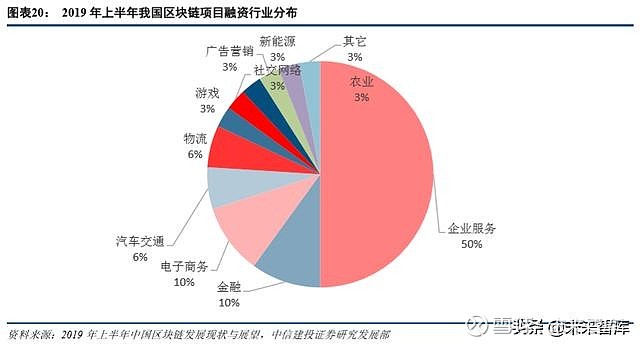
三、区块链在多行业应用逐步深入,多场景在提升效率、保障数据安全、解决中小企业融资问题成果显著
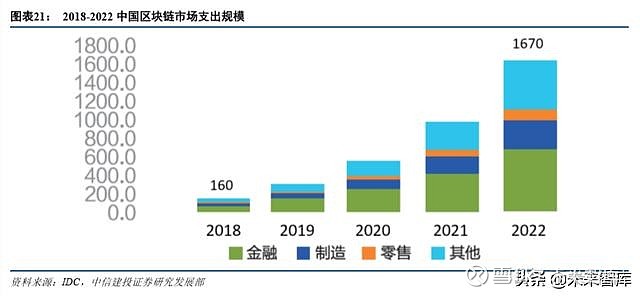
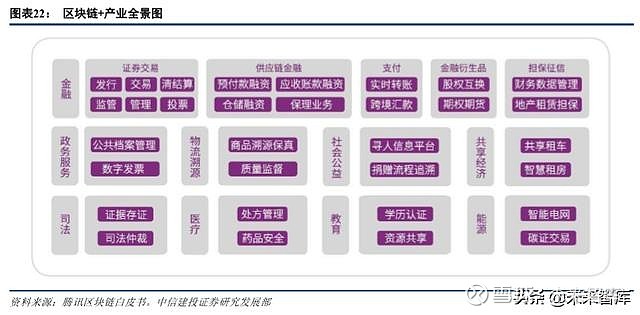
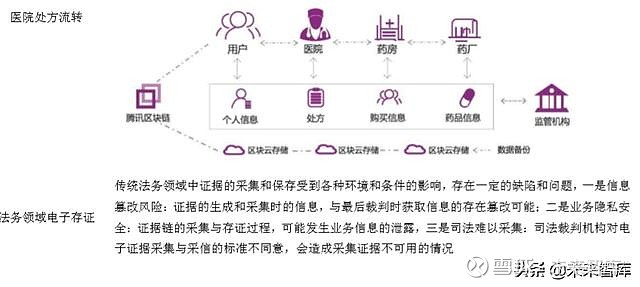
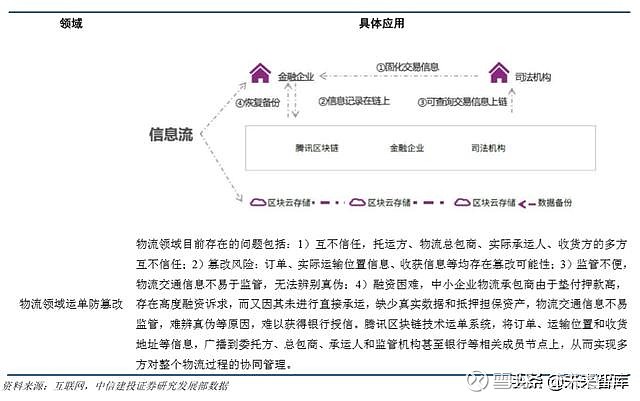
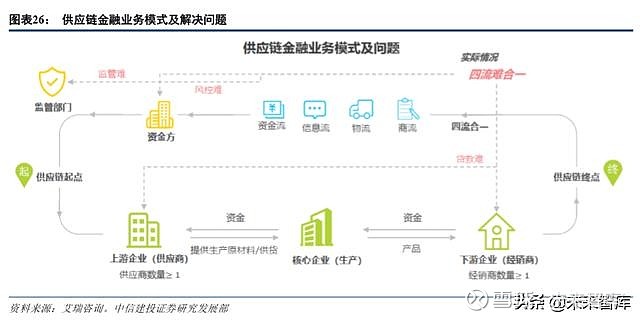
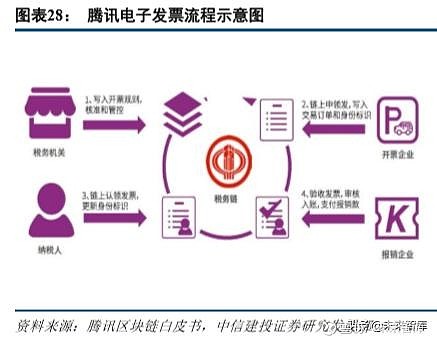
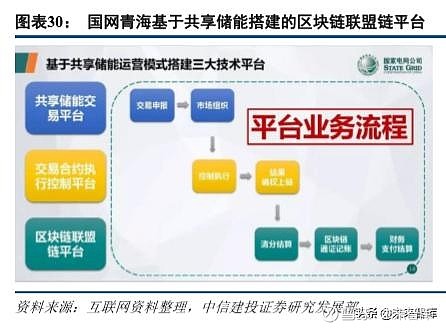
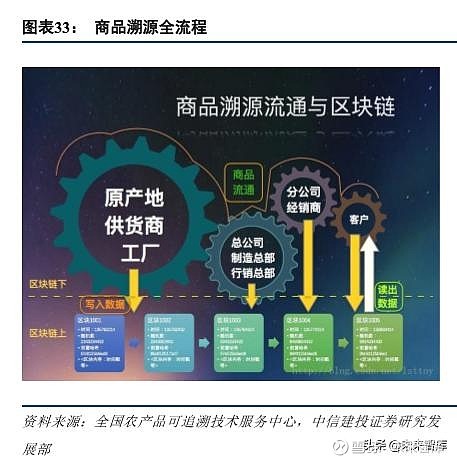
四、A 股产业区块链标的举例
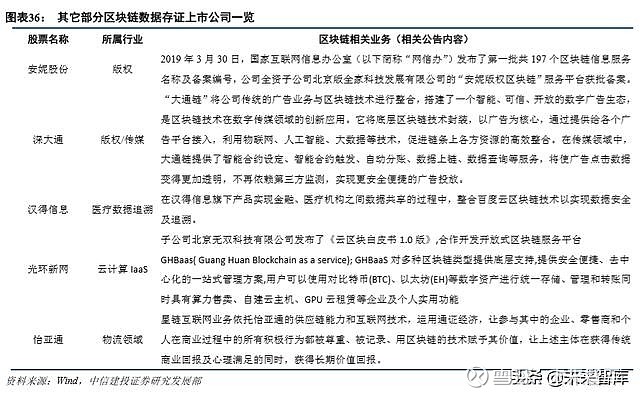
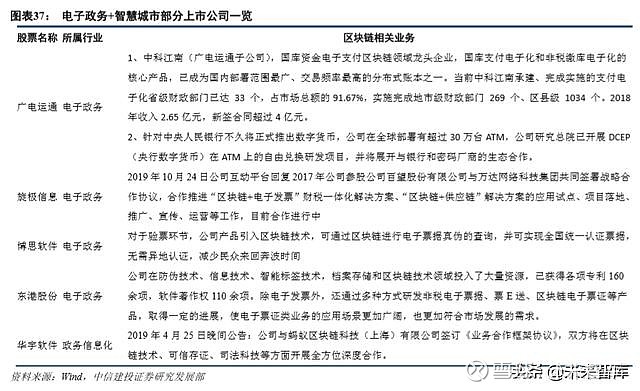
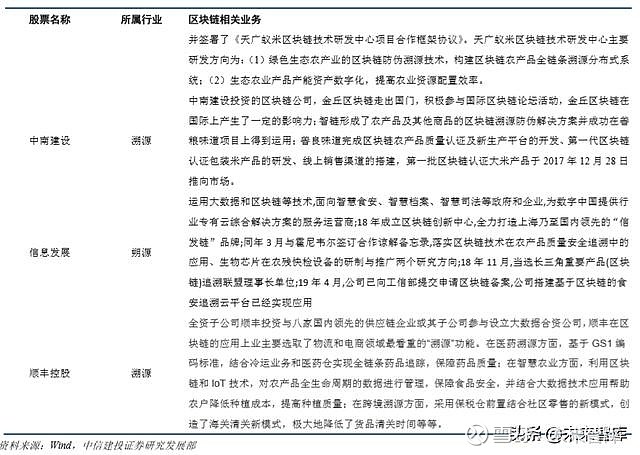
注册有任何问题请添加 微信:MVIP619 拉你进入群

打开微信扫一扫
添加客服
进入交流群










发表评论